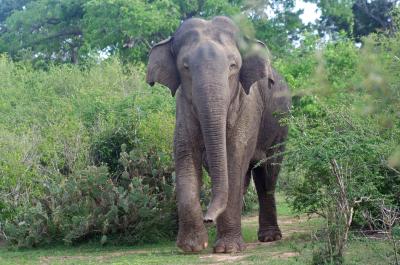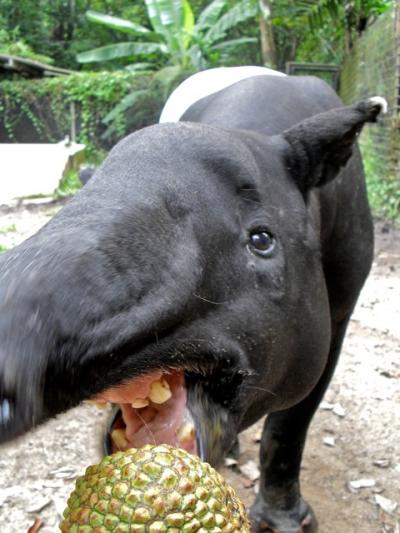Rhinoceros' & Elephants' Seed-Eating Habit Helps Biodiversity

Elephants and rhinoceroses are essential to keeping biodiversity levels high, new research suggests.
In areas where these large seed-dispersing animals have disappeared, like the tropical forest of South-East Asia, researchers found that biodiversity dropped off. Other herbivores like the small pig-looking tapir can't replace these large grazers.
"Megaherbivores act as the 'gardeners' of humid tropical forests: They are vital to forest regeneration and maintain its structure and biodiversity," study researcher Ahimsa Campos-Arceiz, of the University of Nottingham in Malaysia, said in a statement.
The research was detailed in the March 2012 issue of the journal Biotropica.
Seeds in the forest
In these forests in East Asia, the large diversity of plant species means that there is not enough space for all the trees to spread their seeds and grow. As well as the scarce light, seed dispersion is made more complicated by the lack of wind due to the trees that are up to 300 feet (90 meters) high. Plant life is then limited to seeds dispersed by those animals that eat pulp. They either scatter seeds by dropping their food, vomiting it up or by pooping it out later on.
In the case of large seeds, "plants need a large animal capable of eating, transporting and defecating the seeds in good conditions," study researcher Luis Santamaría, of the Mediterranean Institute for Advanced Studies, said in a statement.
Sign up for the Live Science daily newsletter now
Get the world’s most fascinating discoveries delivered straight to your inbox.
This is where elephants and rhinoceroses come into play. They can scatter large quantities of seeds thanks to the fact that they slowly digest very little of their food.
However, habitat loss, poaching, and the conflict between elephant and man has caused a 95 percent loss in Asian elephant (Elephas maximus) historical distribution range and has left the rhinoceros just a step away from extinction: There are less than 50 Java rhinoceroses (Rhinoceros sondaicus) and 200 Sumatra rhinoceroses (Dicerorhinus sumatrensis).
According to the red list of the International Union for Conservation of Nature, elephants are in "danger of extinction" and the two rhinoceros species are "critically endangered."
Asian tapirs are no elephants

In light of the situation, the research team evaluated the seed-dispersing capacity of another large herbivore weighing more than 600 pounds (300 kilograms). For cultural reasons it is not hunted and has a similar digestive system to that of elephants and rhinoceroses: The Asian tapir (Tapirus indicus).
The study allowed researchers to analyze the effect of dispersion by tapirs on the seed survival of nine different plants. This included some large plant species such as the mango tree and durian, as well as other smaller species like the elephant apple (Dillenia indica).
Among other outcomes, the results show that tapirs pooped out 8 percent of the tamarind seeds they ate (none of which germinated). This is pitifully small compared to elephants, who defecated 75 percent of the 2,390 ingested seeds (65 percent of which germinated).
"The Asian tapirs spit, chew or digest the majority of large seeds. This either destroys them or leaves them in the same place. As a result, they are not good dispersers for plants with large fruits and seeds," Campos-Arceiz said. In this sense, "given the role that they play they belong to a different group to elephants and rhinoceroses."
Stopping illegal hunting is the priority
"If these megaherbivores [like elephants and rhinoceroses] disappear from the ecosystem, their contribution to ecological processes will too be lost and the path of the ecosystem will change irreversibly," Campos-Arceiz said. "The most probable consequences are the change in the structure of the undergrowth and the forest and the loss of certain species."
Without large herbivores, new large seed plants will always grow in close proximity to the mother plant and are therefore "unable to colonize available space in other forest areas," Luis Santamaría said.
In this respect, those species that depend on large animals will become increasingly rare whereas those that depend on the wind and smaller, abundant animals will increase in terms of density and dominance. Campos-Arceiz asserts that "at the end of the day, the composition and structure of the forest changes and ends up becoming less complex on a structural and functional level: this translates as a loss of biodiversity."
To avoid such a scenario, researchers suggest that megafauna should be protected and in some cases megaherbivores should be reintroduced into areas from where they had previously disappeared, the researchers said.
Follow LiveScience for the latest in science news and discoveries on Twitter @livescience and on Facebook.










